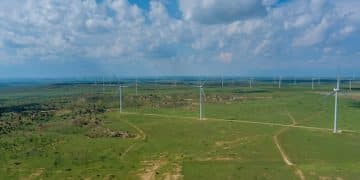Data Analytics in US Energy: Optimize Operations & Cut Costs

Energy companies in the US market can leverage data analytics to optimize operations and reduce costs by improving efficiency, forecasting demand, enhancing grid management, and streamlining maintenance processes.
The US energy market is undergoing a massive transformation, and in the middle of it are energy companies looking for ways to improve their operations and also keep costs low. So, how can energy companies use data analytics to optimize their operations and reduce costs in the US market? Data analytics provides these companies with the necessary tools to identify the potential areas for improvement, make informed decision, and ultimately increase profitability.
Understanding the Role of Data Analytics in Energy
Data analytics is now very important to almost every industry, and the energy sector is no exception, particularly in a big and demanding market like the United States. It gives decision-makers insights that were previously unobtainable, allowing them to improve operational efficiency, better manage resources, and cut costs.
Data analytics helps energy firms make smarter decisions by processing vast amounts of data from many sources, including smart grids, consumer usage patterns, and market trends. When these data streams are properly examined, they show hidden patterns and trends that can lead to considerable improvements.

Enhancing Decision-Making
Data analytics changes decision-making processes at energy firms. Instead of making judgments based on assumptions, executives can use data-driven insights to create strategies and take actions.
- Improved Accuracy: Data analytics reduces errors in predicting and planning, resulting in more dependable outcomes.
- Strategic Planning: Companies can discover long-term possibilities and dangers, allowing them to plan more effectively for the future.
- Resource Allocation: Resources are assigned more efficiently to maximize output and avoid waste.
Data analytics enables energy firms to respond swiftly and successfully to market conditions, regulatory changes, and technological advances. Data insights can aid in making vital choices ranging from optimizing energy distribution to investing in renewable energy sources.
Optimizing Energy Production and Distribution
Energy firms can use data analytics to improve their production and distribution processes. These technologies offer insights into real-time operations, enabling businesses to fine-tune their procedures and increase efficiency.
Data analytics can find inefficiencies and bottlenecks in the energy production process by evaluating data from sensors, meters, and other monitoring equipment. Businesses can resolve these difficulties by optimizing the settings of their equipment, streamlining operations, and reducing downtime.
Real-Time Monitoring
Data analytics provides real-time monitoring tools that enable businesses to stay on top of their operations and make fast modifications as needed.
- Predictive Maintenance: Data analytics can forecast when equipment will need maintenance, allowing businesses to plan repairs and avoid expensive breakdowns.
- Grid Optimization: Data analytics can help utilities optimize grid operations, lowering congestion and improving reliability by tracking energy flow patterns and demand levels.
- Demand Response: Energy companies can successfully implement demand response strategies, lowering peak demand and balancing the grid by assessing consumer energy usage data.
Energy firms can increase productivity, minimize waste, and deliver energy to consumers more dependably and efficiently by employing data analytics to optimize production and distribution. This results in cost savings as well as a more sustainable and reliable energy infrastructure.

Predictive Maintenance and Equipment Monitoring
Predictive maintenance is a major benefit of utilizing data analytics in the energy business. Energy firms may schedule maintenance, lower downtime, and extend the life of their equipment by utilizing data-driven insights.
Predictive maintenance entails acquiring operational data from sensors, meters, and other monitoring technologies. Analytical algorithms are used to evaluate this data in order to detect patterns and anomalies that may point to potential equipment failures. Energy firms can arrange maintenance operations in advance by recognizing these early warning indicators, averting unanticipated breakdowns and costly repairs.
Benefits of Predictive Maintenance
Predictive maintenance provides a number of benefits for energy firms looking to improve the dependability of their equipment and cut maintenance expenses.
- Reduced Downtime: Predictive maintenance helps energy firms minimize downtime by proactively planning maintenance, resulting in continuous operations.
- Extended Equipment Life: Energy firms can extend the life of their equipment and postpone replacement costs by addressing concerns before they escalate.
- Cost Savings: Predictive maintenance helps energy firms save money on maintenance by reducing the requirement for emergency repairs and maximizing the efficiency of maintenance operations.
Energy firms can save money while improving the efficiency and dependability of their operations by incorporating predictive maintenance programs enabled by data analytics. It ensures that equipment is maintained to its best potential, lowering the danger of failures and maximizing energy production.
Forecasting Energy Demand and Supply
Accurate forecasting of energy demand and supply is essential for energy firms to efficiently manage resources, optimize operations, and ensure grid stability. Companies can make informed decisions regarding production, distribution, and procurement by utilizing data analytics to anticipate energy demand and supply.
There are various data sources that can be utilized to forecast energy demand and supply, including historical usage patterns, weather projections, economic indicators, and demographic data. To create accurate forecasts, analytical algorithms are used to evaluate these data and identify trends, seasonal variations, and correlations.
Improving Forecasting Accuracy
Energy firms can improve the accuracy of their energy demand and supply forecasts by utilizing sophisticated data analytics tools and strategies.
- Machine Learning: Machine learning algorithms can detect complicated patterns and correlations in data, allowing for more accurate forecasting.
- Real-Time Data: Integrating real-time data from sensors, meters, and other sources improves forecast accuracy by reflecting current market conditions.
- Scenario Analysis: Performing scenario analysis can assist energy firms in analyzing the impact of different circumstances on energy demand and supply, allowing them to produce more robust forecasts.
Energy firms can better match supply with demand, reduce imbalances, and optimize resource allocation by utilizing data analytics to improve energy demand and supply estimates. This results in lower expenses, increased grid stability, and a more dependable energy delivery system.
Enhancing Customer Engagement and Services
Energy firms can use data analytics to improve customer service, personalize service, and increase customer satisfaction. Energy firms can better understand customer requirements, interests, and usage patterns by analyzing customer data.
Energy firms can gather data from a variety of sources, including client surveys, smart meter data, and CRM systems. To uncover insights into customer behavior and preferences, analytical algorithms are used to evaluate this data. By using this information, businesses can create customer-specific products, services, and marketing campaigns.
Personalized Customer Experiences
Data analytics allows energy firms to provide personalized experiences that increase customer loyalty and engagement.
- Targeted Marketing: Energy firms can target marketing communications to specific consumer groups by evaluating demographic data, usage patterns, and preferences.
- Personalized Recommendations: By studying energy usage patterns, businesses can make tailored energy-saving suggestions to clients, empowering them to save money and reduce their carbon footprint.
- Proactive Support: Energy firms can anticipate customer requirements and provide proactive support by assessing customer data and detecting possible concerns.
Energy firms can build stronger relationships with customers, improve customer satisfaction, and promote brand loyalty by utilizing data analytics to improve customer engagement and services. This results in higher client retention rates as well as a more customer-centric business strategy.
Reducing Energy Consumption and Promoting Sustainability
Energy consumption can be reduced and sustainability can be promoted when energy firms use data analytics. Businesses can assist consumers in conserving energy, lowering their carbon footprint, and supporting a cleaner environment by evaluating energy usage data and detecting inefficiencies.
Energy firms can gather data from smart meters, energy audits, and other sources of customer feedback. In order to discover possibilities for energy savings and sustainability efforts, analytical algorithms are used to analyze this data. This knowledge enables businesses to create focused programs, services, and incentives that encourage consumers to adopt energy-efficient habits.
Data-Driven Sustainability Initiatives
Energy firms can develop data-driven sustainability activities that have a beneficial impact on the environment and community by utilizing data analytics.
- Energy Efficiency Programs: Energy firms can create and implement energy efficiency initiatives that encourage consumers to invest in energy-saving technologies and habits.
- Renewable Energy Adoption: Energy firms can promote the usage of renewable energy sources such as solar and wind power by examining energy consumption patterns and determining appropriate locations for renewable energy projects.
- Carbon Footprint Reduction: Energy firms can assist consumers in lowering their carbon footprint by offering insights into their energy usage and giving practical strategies for energy conservation.
Energy firms can contribute to a more sustainable future while also lowering energy consumption and promoting environmental responsibility by using data analytics to promote sustainability. This results in environmental advantages as well as a more responsible and sustainable energy sector.
| Key Point | Brief Description |
|---|---|
| 💡 Optimize Production | Improve efficiency and lower costs by identifying and fixing inefficiencies in energy production. |
| ⚙️ Predictive Maintenance | Use predictive repair to reduce downtime and maximize the lives of equipment. |
| 📈 Forecast Demand | Accurately forecast energy needs for better resource allocation and grid reliability. |
| 🌱 Sustainability | Encourage sustainability and decrease carbon footprint by promoting energy efficiency. |
Frequently Asked Questions (FAQ)
▼
Data analytics helps in predicting potential outages, optimizing energy distribution, and quickly responding to grid disturbances, therefore improving the reliability of energy grids.
▼
Predictive analytics, prescriptive analytics, and real-time data monitoring are especially beneficial for optimizing operations, predicting equipment failure, and improving decision-making.
▼
Data analytics analyzes energy consumption patterns, identifies inefficiencies, and promotes actions to lessen energy waste, which saves expenses and helps sustainability.
▼
Challenges include data privacy, data security, and lack of skill. Successfully implementing data analytics requires comprehensive cybersecurity and data protection standards, as well as investing in talent development.
▼
Energy firms can use data analytics to customize their services, provide focused marketing communications, and anticipate customer requirements, resulting in higher customer satisfaction and loyalty.
Conclusion
In conclusion, data analytics has the power to significantly transform energy firms in the US market. By incorporating data-driven decision-making, these firms can optimize their operations, cut expenditures, improve customer service, promote sustainability, and remain competitive in an ever-changing industry.





